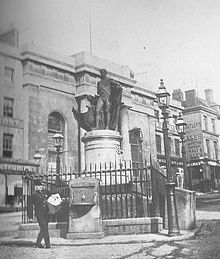| This article includes a list of general references, but it lacks sufficient corresponding inline citations. Please help to improve this article by introducing more precise citations. (June 2008) (Learn how and when to remove this message) |


The Statue of Horatio Nelson, 1st Viscount Nelson, by Richard Westmacott stands in the Bull Ring, Birmingham, England.
Subscription
This bronze statue was the first publicly funded statue in Birmingham, and the first statue of Lord Nelson in Britain. It was made in 1809 by public subscription of £2,500 by the people of Birmingham following Nelson's visit to the town on 31 August 1802, the year before he sailed against the fleets of Napoleon. The statue was unveiled on 25 October 1809, that being the day decreed as the official Golden Jubilee of George III.
Description

Nelson stands in uniform, with his one arm resting on an anchor with the prow of a miniature ship: HMS Victory. Upon the ship is the Flag Staff Truck (part of the mast) of the French ship Orient (1791), flagship of the French fleet, sunk at the Battle of the Nile. It originally stood on a cylindrical marble plinth carved with the people of Birmingham, surrounded by iron railings with lanterns standing on upended cannon at each corner.
The statue was originally erected on the site of the Old Cross, a two-storey building (a meeting hall over an open space), built in 1703 and demolished in August 1784. It stood outside the Market Hall (opened adjacent to it in 1835). Since 25 April 1952 it has had Grade II* listed status.
A related statue was constructed in Bridgetown, Barbados, in 1813. Like the Birmingham statue, it was also sculpted by Westmacott, and based on the same design.
The statue was moved in 1961 during the first redevelopment of the Bull Ring and the carved plinth, cannon and lanterns lost. After the recent redevelopment it has returned close to its original location north of the church. It stands on the high balcony between the Bullring shopping centre and the Selfridges store. Nelson now looks again over the church of St Martin in the Bull Ring. He now stands on a plain plinth, surrounded by iron railings linked by iron rope. These railings were the original railings, but were delayed from being installed by objections on the grounds of Health & Safety from the Bullring. However, the railings were restored in September 2005, just in time for the Trafalgar Bicentenary celebrations which centred on the statue.
The statue forms the centrepiece of Birmingham's annual Trafalgar Day commemoration.
In 2009, to mark the 200th anniversary of the statue's unveiling, a medal was struck by St Paul's Mint of Birmingham.
References
- Historic England. "Details from listed building database (1343362)". National Heritage List for England. Retrieved 19 November 2006.
- "Admiral Horatio Nelson Statue - Bridgetown, Barbados - Maritime Monuments and Memorials on Waymarking.com". www.waymarking.com. Retrieved 26 March 2019.
Sources
- Solid Citizens – Statues in Birmingham, Bridget Pugh and Anne Irby Crews, 1983, Westwood Press, Sutton Coldfield, ISBN 0-9502636-5-6
- Public Sculpture of Birmingham including Sutton Coldfield, George T. Noszlopy, edited Jeremy Beach, 1998, ISBN 0-85323-692-5
- A History of Birmingham, Chris Upton, 1993, ISBN 0-85033-870-0
| Richard Westmacott | |
|---|---|
| Sculptures |
|
| Family |
|
| Public art and memorials in Birmingham | |
|---|---|
| Statues | |
| Sculpture | |
| Murals | |
| Lost | |
| Notable artists | |
52°28′39″N 1°53′38″W / 52.4775°N 1.8939°W / 52.4775; -1.8939
Categories:- Outdoor sculptures in Birmingham, West Midlands
- History of Birmingham, West Midlands
- Grade II* listed buildings in Birmingham
- 1809 sculptures
- Monuments and memorials to Horatio Nelson
- Bronze sculptures in England
- Statues in England
- Grade II* listed monuments and memorials
- Monuments and memorials in Birmingham, West Midlands
- Sculptures by Richard Westmacott
- Vandalized works of art in the United Kingdom